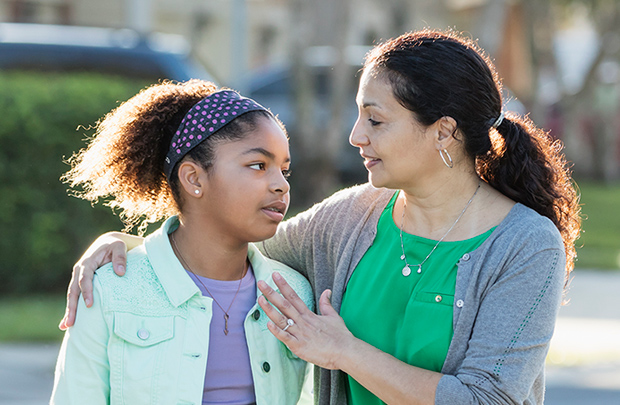
Most children in adoption, kinship care, and foster care have experienced significant losses—usually including their first families, their homes, and the life they once knew. As a result, children are often grieving. That grief can result in behaviors that, while normal and adaptive, can be challenging for caregivers.
Possible losses could include:
- Relationships—birth family members, neighbors, friends, teachers, other caregivers, pets
- Objects that give comfort—toys, blankets, clothing
- Secure, familiar environment—food/smells, neighborhoods, parks, school, familiar habits and routines
- Sense of self (ways of being and doing that define us uniquely), including race, culture, traditions, and country
- Control—over where they live, how they live, and the direction of their lives
As a parent or caregiver, it may be hard to know when your child is struggling to process a loss. Some children speak openly about their losses while others may not have the verbal ability or sense of emotional security to express their grief.
How loss leads to grief
Grief is what you think and feel on the inside following a significant loss. Grief looks different for each child, just as it does for adults. Although we hear about the five stages of grief—denial, bargaining, anger, depression, and acceptance—grief can feel more like a roller coaster than an ordered series of stages.
Most children will likely move among the stages of grief for years and may cycle through various stages; it is usually not a linear process. Grief may present through emotions, health, or behaviors in children.
- Angry outbursts or acting-out behavior
- Difficulty concentrating in school or falling grades
- Symptoms of anxiety or depression
- Feeling undefined or unexplained guilt
- Feeling especially different from others
- Anger toward or mistrust of adults
- Too much or too little intimacy with others
- Difficulty forming relationships with peers or adults
- Feeling uncertain or afraid of the future
- Experiencing confusing memories or fears
- Frequent crying
- Making up stories about their past or present experiences
- Hyperactivity or poor impulse control
- Feeling overwhelmed by choices or decisions
Helping your child through grief and loss
Once you understand what grief and loss look like, how do you help a child work through them?
There is no one right answer to this. Each child and situation is unique. Regardless of the situation, children need the opportunity, space, and support to process their losses and come to a place of integration and healing. Here are some possible strategies you can use to help your children:
- Give opportunities for them to explore their adoption or foster care story. Let them explore their feelings and thoughts about their birth family without judgment.
- Acknowledge the missing pieces of their story. You may not have all of the information children want about their life before they came to your home. It’s important to not invent information when we don’t have answers. If you don’t know, you don’t know. Acknowledge the difficulty of not having clear or thorough information and allow your child to grieve the unknown.
- Hold or comfort them when they cry. Don’t try to fix or make it better. Just be there and let them be sad or angry. Some children were taught not to cry. Help them understand how healing crying is. Let them see you cry.
- Take care of yourself so that you can take care of your child. If you have unresolved feelings about your own loss experiences, it can be harder for you to help your child through their grief. Process your own feelings so that you can be present with your child.
- Model and teach your child how to grieve, such as writing in a journal, exercising, drawing a picture or making a craft related to their emotions, coming to you, sitting alone when needed, or talking to a friend.
- Find a therapist to help your child. Look for adoption- and permanency-competent providers.
- Do not push your child to work through something if they’re not ready. You can make sure to be there when they are ready by giving them ample opportunities to talk about their adoption or foster care experience.
- Create a life book with your child. This project can help create special bonds with them, and allow your child to creatively work through any grief and loss they may feel.
- Plant a tree or garden in honor of someone and allow your child to care for it regularly. This ongoing action is a tangible way to connect and help children to process loss.
- When grief displays in aggressive behaviors, consider giving your child a physical outlet for expressing feelings in a healthy way.
- Use calming tools such as weighted blankets, vests, or lap pads; chewing gum; lollipops; Chewelry; and deep breathing techniques. Blowing bubbles can help a child when they are struggling to control their breathing.
Learn more about loss and grief
These are just a few of the books, videos, and online resources that can help you to learn more about your child’s grief and loss experiences and how to help them heal.
- Grief and Loss in Foster Care, an online course offered by FosterClub which outlines the ways grief and trauma can manifest in a child or youth’s behaviors, and offers ways to help children and youth in foster care cope with feelings of grief and ambiguous loss.
- Resources on grief and loss from the North American Council on Adoptable Children
- Grief and Loss for Children in Foster Care: A video from Dr. Gregory Manning
- Tear Soup: A Recipe for Healing After Loss, by Pat Schwiebert and Chuck DeKlyen (book)
- Healing Your Grieving Heart for Teens: 100 Practical Ideas, by Alan D. Wolfelt, Ph.D. (book)